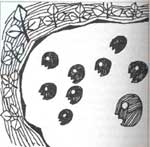Kamikaze microbes
 EVEN as scientists flood the environment with genetically-customised microbes, there is no certainty that these designer creatures will not turn into Frankensteinian horrors. Lest this happens, DNA-manipulators are now tailoring microbes that commit suicide once they serve their purpose.
EVEN as scientists flood the environment with genetically-customised microbes, there is no certainty that these designer creatures will not turn into Frankensteinian horrors. Lest this happens, DNA-manipulators are now tailoring microbes that commit suicide once they serve their purpose.
While it is easy to keep a check on the microbes in the laboratory, the real challenge before researchers is to get a handle on how the bugs live and die in a complex environment (Biotechnology, Vol 13, No 1).
Recently, scientists in Spain, Germany and Denmark developed anti-pollution microbes with a built-in harakiri facility once they have accomplished their mission. This is made possible by a pair of killer genes, which sit inside the microbe and blow them away. One of them is the boss who tells the other when to pull the suicide trigger, since the other is a jitterbug who might pull the trigger even before the microbe has done its job. Field trials on these suicide microbes are under way in Spain.
But the self-destruct programming differs for microbes with different missions -- as brooms for environmental cleaning-up, as inoculants against diseases in agriculture, and as vaccines in healthcare.
In a class of bacteria called Pseudomonas, used in bioremediation, Spanish scientist Juan Carlos Ramon and his colleagues at the Granada-based Institute of Biochemistry, Cellular and Molecular Biology, have stitched 2 genes -- hok (host-killing) and sok (suppression of killing) -- that sabotage the genetic apparatus of the microbe responsible for breaking down the pollutant 3-methylbenzoate. Strategies for other xenobiotics -- substances, especially synthetic chemicals, foreign to the body or to an ecological system -- such as toluene, phenols and naphthalene are being designed.
Designing biological containment systems for organisms used in agriculture -- Bacillus thuringiensis in insect control, for instance -- is not so straightforward. This is because the interaction between plants and microbes is poorly understood. However, scientists are now exploiting the microbial response to environmental stresses, such as starvation or temperature changes, as a weapon against them. The idea is to insert suicide genes that subvert the microbe's ability to survive these stresses. Researchers are also working on genes that bomb the reproductive systems of microbes like B thurigiensis.
Live vaccines such as engineered strains of Salmonella and Escherichia coli are difficult to get rid of. Researchers are now attempting to destroy them by exploiting their different growth rates inside and outside the gut. Taking off from genes that switch on and off with a set frequency, they are trying to design a suicide system that is deadliest when the microbe cells grow slowly, as in conditions outside the gut, where they are not needed.
Despite considerable successes, however, total containment of organisms has never been achieved. A small population of cells always survives, even in the presence of the suicide-facilitator. This may be because of mutations in the killer genes. One way to reduce the mutation problem, say scientists, is to provide not one assassin but a lynch mob of specialised killers in each cell.
